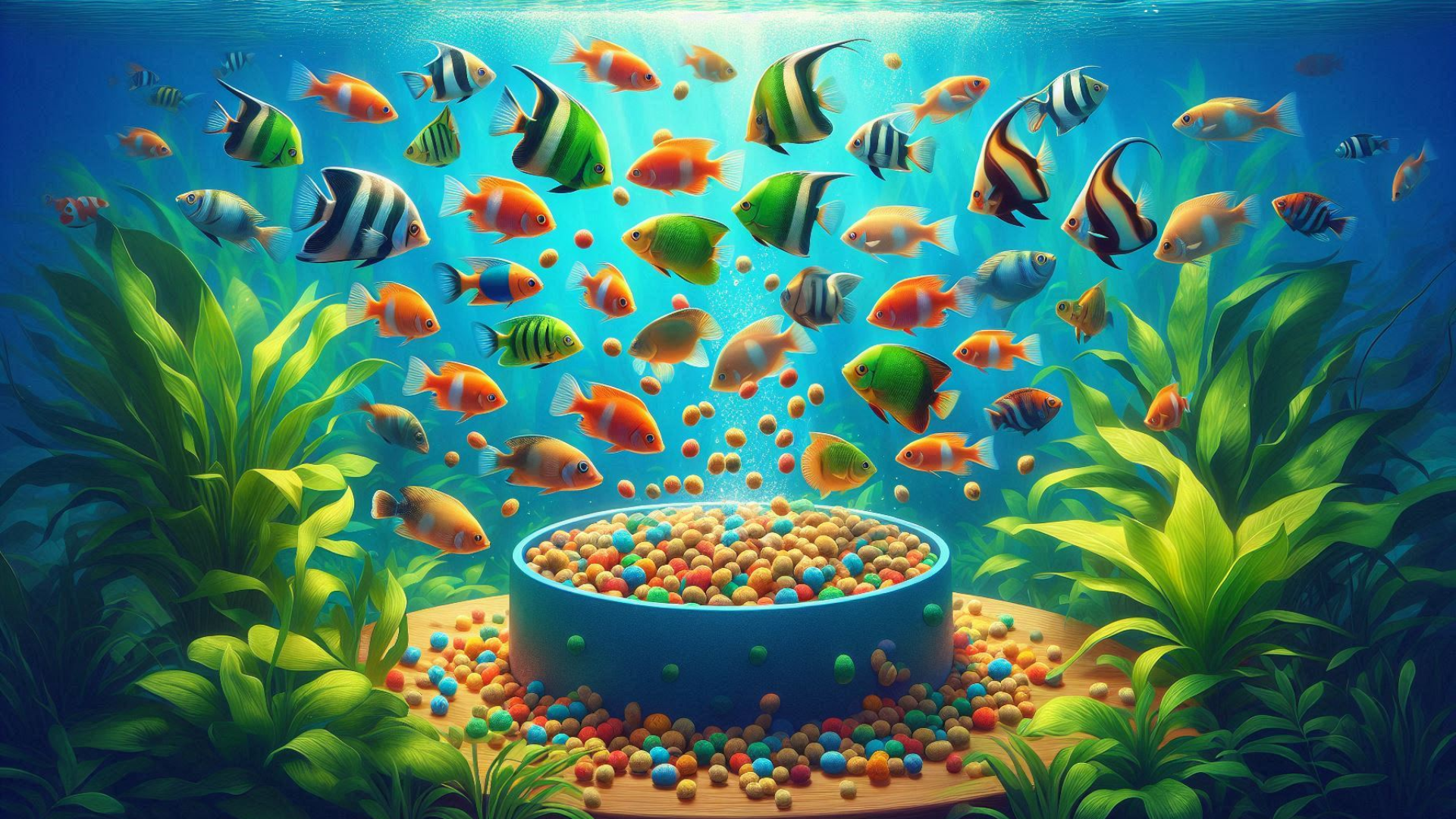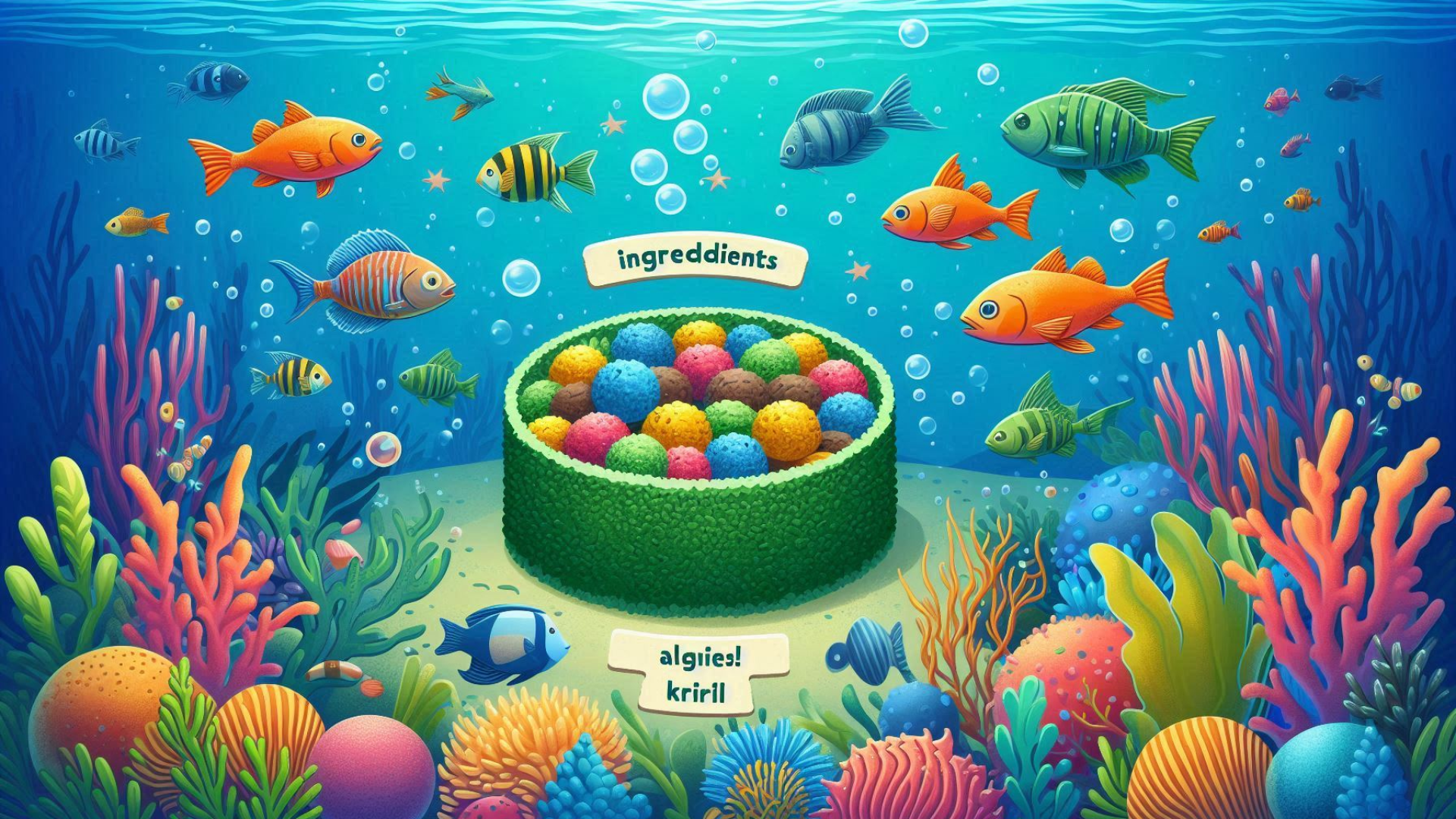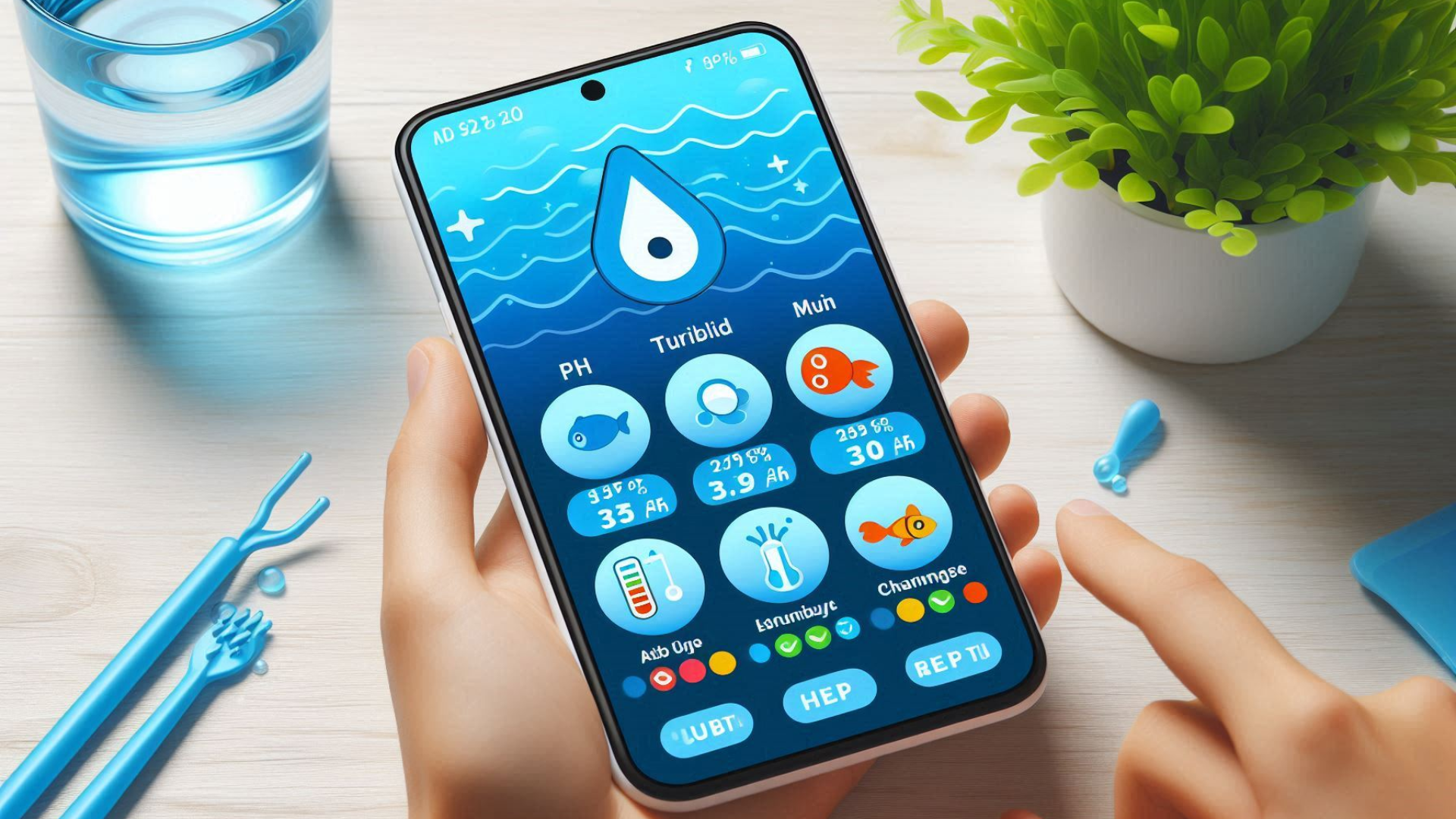A detail review on Floating Fish Feed Vs Sinking Fish Feed – Selecting the appropriate feed type is crucial for the success and efficiency of any aquaculture operation. Floating fish feed and sinking fish feed are two primary options available in the market, each with its unique characteristics and benefits. Understanding the differences between these feed types and their suitability for various fish species and farming conditions is essential for optimizing feed utilization, fish growth, and overall profitability. In this comprehensive article, we will delve into the world of floating fish feed vs sinking fish feed, exploring their properties, advantages, and factors to consider when making the right choice for your aquaculture system.

Understanding Fish Feeding Behavior
Before diving into the specifics of floating and sinking fish feed, it is important to grasp the fundamental aspects of fish feeding behavior. Different fish species have evolved to feed at various levels in the water column, and their feeding habits play a significant role in determining the most suitable feed type.
Surface Feeders and Their Preferences
Surface feeders, such as tilapia, trout, and most cyprinids, prefer to feed at the water’s surface. These fish species have upturned mouths and are adapted to consuming food particles that float on the water’s surface. For surface feeders, floating fish feed is the ideal choice as it remains accessible at the top of the water column, allowing the fish to feed comfortably and efficiently.
Bottom Feeders and Their Requirements
On the other hand, bottom feeders, like catfish, shrimp, and some species of carp, are adapted to foraging for food on the pond or tank bottom. These species have downturned mouths and are equipped with sensory barbels that help them locate food in the substrate. Sinking fish feed, which settles to the bottom, is more suitable for bottom feeders as it mimics their natural feeding behavior and ensures that the feed is readily available in their preferred feeding zone.
Feeding Habits of Different Fish Species
Understanding the specific feeding habits of the fish species being cultured is crucial for selecting the appropriate feed type. Some species, such as tilapia, are omnivorous and can adapt to both floating and sinking feed, depending on their life stage and the farming system. Other species, like salmon and trout, are primarily surface feeders and require floating feed for optimal growth and feed efficiency. Shrimp and other crustaceans, being bottom dwellers, rely on sinking feed for their nutritional needs. Tailoring the feed type to the target species’ feeding behavior ensures better feed utilization and minimizes waste.
Floating Fish Feed
Floating fish feed is a popular choice in modern aquaculture due to its numerous advantages and ease of use. This type of feed is designed to remain afloat on the water’s surface for an extended period, allowing fish to consume the pellets at their preferred feeding zone.
Definition and Characteristics
Floating fish feed is characterized by its buoyancy, which is achieved through the use of specific ingredients and advanced manufacturing processes. The pellets have a lower density than water, enabling them to float on the surface. Floating feed typically has a porous texture and a high oil content, which contributes to its water stability and palatability.
Advantages of Floating Fish Feed
- Improved Feeding Efficiency Floating feed allows farmers to observe the feeding behavior of their fish and monitor feed consumption more effectively. As the pellets remain visible on the surface, it is easier to determine when the fish have reached satiation and adjust the feeding rate accordingly. This visual control helps prevent overfeeding and minimizes feed waste, leading to improved feed conversion ratios (FCR) and cost savings.
- Reduced Water Pollution When fish consume floating feed at the surface, there is less chance of uneaten pellets sinking to the bottom and decomposing, which can lead to water quality issues. By minimizing feed waste and ensuring better feed utilization, floating feed helps maintain cleaner pond or tank bottoms and reduces the risk of water pollution.
- Better Observation of Fish Health As fish come to the surface to feed on floating pellets, farmers can easily observe their behavior, appetite, and overall health. Any abnormalities, such as reduced feeding activity or physical signs of disease, can be quickly detected, allowing for timely intervention and management decisions.
Manufacturing Process and Extrusion Technology
Floating fish feed is typically produced using extrusion technology, which involves the application of heat, pressure, and moisture to the raw ingredients. The mixture is forced through a die, creating pellets with a porous structure that allows them to float. The extrusion process also improves the digestibility of the feed by gelatinizing the starches and denaturing the proteins, making the nutrients more bioavailable to the fish.
Extruded floating feed offers several advantages over other manufacturing methods:
- Enhanced water stability: Extruded pellets have a more compact and durable structure, reducing the rate of nutrient leaching and disintegration in water.
- Improved palatability: The extrusion process enhances the taste and aroma of the feed, making it more attractive to fish and encouraging better feed intake.
- Flexibility in formulation: Extrusion allows for the incorporation of a wide range of ingredients, including plant-based proteins, oils, and functional additives, enabling the production of tailored feed formulations for specific fish species and life stages.
Sinking Fish Feed
Sinking fish feed, as the name suggests, is designed to sink to the bottom of the pond or tank after being introduced into the water. This type of feed is particularly suitable for bottom-dwelling species and those that prefer to feed in the lower levels of the water column.
Definition and Characteristics
Sinking fish feed is characterized by its higher density compared to water, which causes the pellets to sink rapidly after being cast. The pellets are typically more compact and have a lower oil content than floating feed, contributing to their sinking properties. Sinking feed can be produced in various sizes and shapes to cater to the preferences of different fish species and life stages.
Benefits of Sinking Fish Feed
- Suitable for Bottom Feeders Sinking feed is the preferred choice for bottom-dwelling species, such as catfish, shrimp, and some species of carp. These species are adapted to foraging for food on the pond or tank bottom, and sinking pellets mimic their natural feeding behavior, ensuring better feed accessibility and utilization.
- Nutrient Retention and Stability Sinking feed pellets generally have a more compact structure and lower porosity compared to floating feed. This characteristic helps reduce nutrient leaching and maintains the pellets’ integrity for a longer period underwater. The improved nutrient retention ensures that the fish receive the intended nutritional value from the feed, even if they consume it at a slower pace.
- Slower Feeding and Better Digestion As sinking feed settles to the bottom, fish have more time to locate and consume the pellets at their own pace. This slower feeding behavior can lead to better digestion and nutrient absorption, as the fish have more time to break down the feed in their digestive system. The gradual feeding also reduces the risk of overfeeding and digestive issues associated with rapid feed intake.
Production Methods and Pellet Density
Sinking fish feed can be produced using various methods, including pelleting, extrusion, and steam conditioning. The choice of production method depends on the desired pellet density, stability, and nutritional profile.
- Pelleting: This is the most common method for producing sinking feed. The raw ingredients are ground, mixed, and conditioned with steam before being pressed through a die to form compact pellets. The pellets are then cooled and dried to achieve the desired moisture content and density.
- Extrusion: Although extrusion is primarily used for producing floating feed, it can also be employed to create slow-sinking or semi-buoyant pellets by adjusting the process parameters and ingredient composition. Extruded sinking feed offers improved water stability and nutrient retention compared to pelleted feed.
- Steam conditioning: This method involves the application of steam to the raw ingredients before pelleting, which helps gelatinize the starches and improve pellet binding. Steam-conditioned sinking feed has better water stability and reduced fines compared to regular pelleted feed.
The density of sinking feed pellets can be controlled by adjusting the ingredient composition, particularly the inclusion of high-density materials like mineral premixes and binders. The desired sinking rate can be achieved by fine-tuning the pellet density to suit the feeding behavior and preferences of the target fish species.
Factors Affecting Feed Choice
Choosing between floating and sinking fish feed depends on several factors that influence the feeding efficiency, fish performance, and overall success of the aquaculture operation. Some of the key considerations include:
Fish Species and Their Feeding Habits
The feeding behavior and preferences of the cultured fish species are the primary determinants of feed choice. Surface feeders, like tilapia and trout, are best served with floating feed, while bottom feeders, such as catfish and shrimp, require sinking feed for optimal growth and feed utilization. Understanding the natural feeding habits of the target species is essential for selecting the most appropriate feed type.
Aquaculture System and Environment
The type of aquaculture system and its environmental conditions also play a role in feed selection. In ponds with natural productivity, sinking feed can help supplement the available natural food at the bottom, promoting better growth and reducing feed costs. In intensive tank-based systems, floating feed may be preferred for easier monitoring and management of feed intake.
Water depth and clarity are other factors to consider. In shallow ponds or tanks, floating feed allows for better observation and control of feeding activity. In deeper or turbid waters, sinking feed may be more suitable to ensure feed availability to the fish at various depths.
Water Quality and Temperature
Water quality parameters, such as dissolved oxygen, pH, and temperature, can influence the choice of feed type. In high-temperature conditions or systems with limited water exchange, floating feed may be preferred to minimize feed waste and maintain better water quality. Sinking feed, on the other hand, may be more suitable in cooler temperatures or well-oxygenated systems, as it allows for a slower feeding process and reduces the risk of feed decomposition at the surface.
Feed Ingredients and Nutritional Requirements
The nutritional requirements of the cultured fish species and the availability of feed ingredients also influence the choice between floating and sinking feed. Some ingredients, like plant-based proteins and oils, are more conducive to producing floating pellets due to their lower density and higher oil content. Other ingredients, such as fishmeal and mineral premixes, contribute to the sinking properties of the feed.
Formulating a well-balanced diet that meets the specific nutritional needs of the fish is crucial, regardless of the feed type. The choice of floating or sinking feed should be based on the ability to deliver the required nutrients effectively while considering the feeding behavior and preferences of the target species.
Feed Stability and Nutrient Leaching
Feed stability in water is a critical factor in determining the choice between floating and sinking feed. The ability of the pellets to maintain their integrity and retain nutrients when submerged in water directly impacts the feed efficiency and water quality of the aquaculture system.
Importance of Feed Stability in Water
Feed stability refers to the ability of the pellets to resist disintegration and nutrient leaching when exposed to water. A stable feed ensures that the fish consume the pellets in their intact form, receiving the intended nutritional value. Unstable feed, on the other hand, can lead to rapid disintegration, resulting in nutrient loss and water pollution.
Floating feed generally requires higher water stability than sinking feed, as it remains exposed to water for a longer duration. The porous structure of floating pellets makes them more susceptible to moisture penetration and nutrient leaching, necessitating the use of binders and other stabilizing agents in the feed formulation.
Nutrient Leaching in Floating and Sinking Feed
Nutrient leaching occurs when water-soluble nutrients, such as vitamins and minerals, dissolve and escape from the feed pellets into the surrounding water. The rate of nutrient leaching depends on factors such as pellet composition, manufacturing process, and water temperature.
Floating feed, due to its porous structure and longer exposure to water, is more prone to nutrient leaching compared to sinking feed. The leached nutrients not only represent an economic loss but can also contribute to water quality deterioration and eutrophication.
Sinking feed, with its more compact structure and faster sinking rate, is less susceptible to nutrient leaching. However, the rate of leaching can still be significant if the pellets remain unconsumed at the bottom for extended periods.
Strategies to Improve Feed Stability
Ensuring feed stability is crucial for maximizing the efficiency of aquaculture operations and minimizing the environmental impact of fish farming. Unstable feed can lead to nutrient leaching, water pollution, and economic losses. To address these challenges, several strategies can be implemented to enhance the stability of both floating and sinking fish feed:
- Optimal ingredient selection: Choosing high-quality, stable ingredients is the foundation of producing stable fish feed. Ingredients with good binding properties, such as wheat gluten, gelatinized starch, and certain gums, can help improve pellet integrity and reduce disintegration in water. The inclusion of these ingredients in the feed formulation can significantly enhance feed stability.
- Extrusion processing: Extrusion technology has revolutionized the production of stable fish feed. The high temperature and pressure conditions during extrusion cooking cause the starches to gelatinize and the proteins to denature, creating a more compact and durable pellet structure. Extruded feed, both floating and sinking, exhibits superior water stability compared to pelleted feed, reducing nutrient leaching and maintaining pellet integrity for longer periods.
- Binder and stabilizer inclusion: The incorporation of binders and stabilizers in the feed formulation is another effective strategy to improve feed stability. These additives create a cohesive matrix that holds the pellet together and slows down water penetration. Some commonly used binders and stabilizers include:
- Lignosulfonates: By-products of the wood pulp industry that act as effective binding agents
- Guar gum: A plant-based polysaccharide that enhances pellet durability and water stability
- Bentonite: A clay mineral that improves pellet binding and reduces fines
- Carboxymethylcellulose (CMC): A modified cellulose derivative that acts as a thickening and stabilizing agent
- Lipid coating: Applying a lipid or oil coating to the feed pellets can create a hydrophobic barrier that reduces water penetration and nutrient leaching. This technique is particularly beneficial for floating feed, as it helps maintain buoyancy and prolongs the pellets’ integrity on the water’s surface. Commonly used coating materials include fish oil, vegetable oils, and waxes. The coating process can be carried out post-extrusion or post-pelleting, depending on the specific requirements of the feed.
- Pellet size and density optimization: Adjusting the pellet size and density can contribute to improved feed stability. Smaller pellets have a higher surface area to volume ratio, which can lead to faster water penetration and disintegration. Increasing pellet size, within the limits of the target fish species’ mouth gape, can help reduce the rate of moisture uptake and nutrient leaching. Similarly, increasing pellet density through the use of denser ingredients or by adjusting the extrusion or pelleting process can create a more compact and stable pellet structure.
- Proper storage and handling: Proper storage and handling practices play a vital role in maintaining feed stability. Fish feed should be stored in a cool, dry place, protected from moisture, direct sunlight, and pests. The use of appropriate packaging materials, such as moisture-barrier bags or sealed containers, can help prevent moisture uptake and maintain pellet integrity. Minimizing the time between feed production and use, as well as implementing first-in-first-out (FIFO) inventory management, can further ensure that the feed remains stable and retains its nutritional value.
By implementing these strategies, fish feed manufacturers and aquaculture operators can significantly improve the stability of both floating and sinking feed. Stable feed not only enhances the efficiency of fish farming by reducing waste and optimizing nutrient delivery but also contributes to better water quality and a more sustainable aquaculture industry. As research and development in feed technology continue to advance, new and innovative solutions for enhancing feed stability are expected to emerge, further benefiting the global aquaculture sector.
FAQ – Floating Fish Feed vs Sinking Fish Feed
- What is the main difference between floating and sinking fish feed? The primary difference between floating and sinking fish feed lies in their buoyancy. Floating feed is designed to remain on the water’s surface, while sinking feed is formulated to sink to the bottom of the pond or tank. This difference in buoyancy caters to the feeding preferences of different fish species, with surface feeders benefiting from floating feed and bottom feeders thriving on sinking feed.
- Which type of fish feed is better for surface feeders? Floating fish feed is the ideal choice for surface feeders like tilapia, trout, and most cyprinids. These species have upturned mouths and are adapted to consuming food particles at the water’s surface. Floating feed allows them to feed comfortably and efficiently, as the pellets remain accessible at the top of the water column.
- How does sinking feed benefit bottom-dwelling fish species? Sinking feed is particularly beneficial for bottom-dwelling fish species, such as catfish, shrimp, and some species of carp. These species have downturned mouths and are equipped with sensory barbels that help them locate food in the substrate. Sinking feed mimics their natural feeding behavior, settling to the bottom where they can easily access and consume the pellets.
- What factors should be considered when choosing between floating and sinking feed? When deciding between floating and sinking feed, several factors should be taken into account:
- Fish species and their natural feeding behavior
- Aquaculture system type and environmental conditions
- Water depth and clarity
- Feed ingredients and nutritional requirements
- Feed stability and nutrient leaching
- Feed conversion ratio and growth performance Evaluating these factors will help farmers select the most suitable feed type for their specific aquaculture operation.
- How does the manufacturing process differ for floating and sinking feed? The manufacturing process for floating and sinking feed differs primarily in the extrusion technology used. Floating feed is produced using high-temperature, high-pressure extrusion, which creates a porous, expandable structure that allows the pellets to float. Sinking feed, on the other hand, can be manufactured through pelleting, cold extrusion, or steam conditioning, resulting in denser pellets that sink rapidly in water.
- Can floating feed help reduce water pollution in aquaculture systems? Yes, floating feed can contribute to reducing water pollution in aquaculture systems. As fish consume the floating pellets at the surface, there is less chance of uneaten feed sinking to the bottom and decomposing, which can lead to water quality issues. By minimizing feed waste and ensuring better feed utilization, floating feed helps maintain cleaner pond or tank bottoms and reduces the risk of water pollution.
- What is the role of extrusion technology in producing floating fish feed? Extrusion technology plays a crucial role in producing floating fish feed. The process involves the application of high temperature, pressure, and moisture to the raw ingredients, which are then forced through a die to create pellets with a porous, expandable structure. This porous structure allows the pellets to float on the water’s surface, making them easily accessible to surface-feeding fish species.
- How does pellet size affect fish growth and feed efficiency? Pellet size is an important factor in fish growth and feed efficiency. The size of the pellets should be appropriate for the fish’s mouth size, especially during different developmental stages. Smaller fish require smaller pellets to prevent choking and ensure efficient feed intake, while larger fish can consume bigger pellets. Providing the correct pellet size promotes optimal growth and feed utilization, as fish can easily consume and digest the feed.
- What are some strategies to improve feed stability and reduce nutrient leaching? Several strategies can be employed to enhance feed stability and minimize nutrient leaching:
- Incorporating binders and stabilizers in the feed formulation to improve pellet integrity
- Utilizing extrusion processing to create a more compact pellet structure
- Applying lipid or oil coatings to the pellets to form a hydrophobic barrier
- Optimizing pellet size and density to reduce water penetration and nutrient loss
- Ensuring proper storage conditions to maintain feed quality and prevent moisture exposure Implementing these strategies can significantly improve feed stability, reduce waste, and optimize nutrient delivery to the fish.
- How can farmers optimize their feeding strategies based on the chosen feed type? To optimize feeding strategies based on the selected feed type, farmers should:
- Adjust feeding frequency and timing according to the fish species’ natural feeding behavior
- Monitor feed consumption and waste to prevent overfeeding and ensure efficient utilization
- Regularly assess fish growth and health to evaluate the effectiveness of the feeding program
- Adapt pellet size to the fish’s developmental stage to promote optimal feed intake
- Ensure proper storage and handling of feed to maintain its nutritional quality
- Continuously monitor water quality parameters and make necessary adjustments to the feeding regime By tailoring their feeding strategies to the specific feed type and the needs of their fish, farmers can maximize growth performance, minimize waste, and enhance the overall efficiency of their aquaculture operation.
Conclusion
In conclusion of Floating Fish Feed vs Sinking Fish Feed, understanding the differences between floating fish feed and sinking fish feed is crucial for optimizing aquaculture operations and ensuring the best possible outcomes for fish growth, health, and feed efficiency. The choice between these two feed types depends on a variety of factors, including the fish species being cultured, their natural feeding behavior, the aquaculture system and environment, water quality and temperature, feed ingredients, and nutritional requirements.
Floating fish feed offers several advantages, such as improved feeding efficiency, reduced water pollution, and better observation of fish health. Its manufacturing process, which involves extrusion technology, creates a porous structure that allows the pellets to float on the water’s surface, making them easily accessible to surface feeders like tilapia and trout.
On the other hand, sinking fish feed is particularly beneficial for bottom-dwelling species, such as catfish and shrimp, as it mimics their natural feeding behavior and settles to the bottom where they can easily access and consume the pellets. Sinking feed is typically more compact and has a lower oil content than floating feed, contributing to its sinking properties and better nutrient retention.
Feed stability and nutrient leaching are important considerations when selecting between floating and sinking feed. Strategies such as incorporating binders and stabilizers, utilizing extrusion processing, applying lipid coatings, and optimizing pellet size and density can help improve feed stability and reduce nutrient loss.
Farmers must also consider factors like feed conversion ratio, growth performance, and feeding strategies when choosing the appropriate feed type for their aquaculture operation. By tailoring their feeding strategies to the specific feed type and the needs of their fish, farmers can maximize growth performance, minimize waste, and enhance overall efficiency.
As the aquaculture industry continues to grow and evolve, ongoing research and development in fish feed technology will play a vital role in improving the sustainability, efficiency, and profitability of fish farming operations worldwide. By staying informed about the latest advancements in floating and sinking fish feed, aquaculture professionals can make well-informed decisions that contribute to the success of their operations while promoting the responsible and sustainable production of fish for a growing global population.
Also explore our YouTube Channel Road To Biofloc for getting more information on Biofloc Fish Farming and Shrimp Farming.


